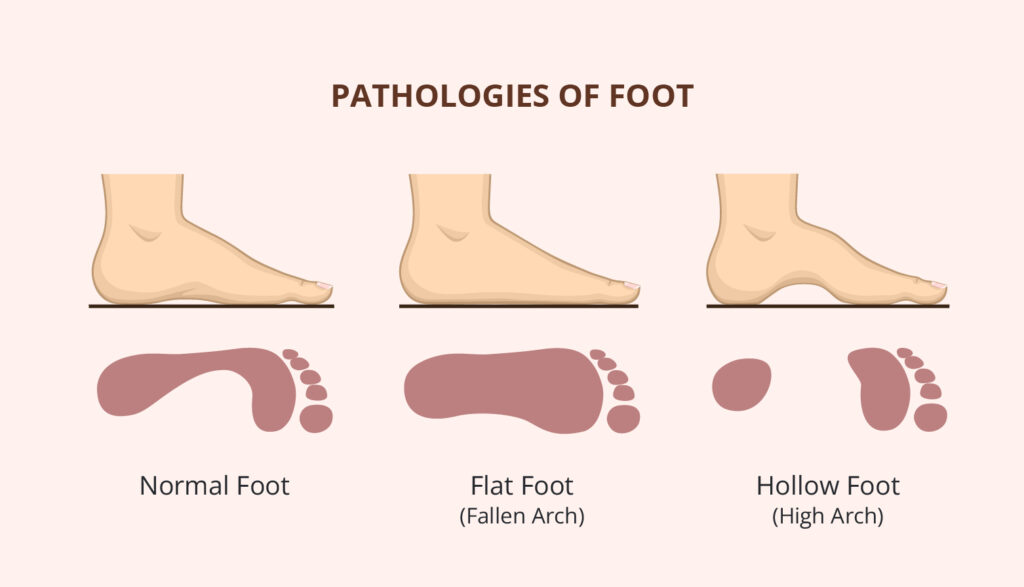Flat foot, medically known as pes planus, is a common condition where the arches of the feet collapse, causing the entire sole to come into contact with the ground.
While flat feet may not always cause discomfort or interfere with daily activities, they can lead to related conditions and complications that require attention.
Understanding flat foot and its related conditions, along with their symptoms and management, is crucial for maintaining foot health and overall well-being.

Understanding Flat Foot:
Flat foot occurs when the arches of the feet fail to develop during childhood or collapse over time due to various factors.
These factors include genetics, foot injuries, muscle or ligament weakness, aging, and obesity.
Individuals with flat feet may experience symptoms such as pain along the inner side of the foot, swelling around the ankle, fatigue, and abnormal foot movement patterns.
Related Conditions:
- Overpronation: Flat foot often leads to overpronation, where the feet roll inward excessively during walking or running. This can cause strain on the ankles, knees, hips, and lower back, leading to pain and discomfort.
- Plantar Fasciitis: Flat foot can contribute to plantar fasciitis, a condition characterized by inflammation of the plantar fascia, a band of tissue that connects the heel bone to the toes. This inflammation causes heel pain, especially in the morning or after prolonged periods of rest.
- Achilles Tendonitis: Individuals with flat feet may also be at risk of developing Achilles tendonitis, which is inflammation of the Achilles tendon that connects the calf muscles to the heel bone. This condition can cause pain and stiffness in the back of the heel and lower calf.
- Shin Splints: Flat foot increases the risk of developing shin splints, which is pain along the shinbone (tibia) caused by inflammation of the muscles, tendons, and bone tissue. Shin splints commonly occur in athletes and individuals engaged in high-impact activities.
Symptoms and Diagnosis:
Diagnosing flat foot and related conditions typically involves a physical examination by a healthcare professional.
Imaging tests such as X-rays, MRI scans, or CT scans may be used to assess the structure of the feet and identify any underlying issues.
Symptoms of flat foot and related conditions may vary but often include pain, swelling, fatigue, and abnormal foot movement patterns.
Management and Treatment for Flat Foot and Related Conditions:
- Orthotic Devices: Orthotic devices are customized or over-the-counter inserts designed to provide support to the arches of the feet. These devices help distribute pressure evenly across the foot, reducing strain and discomfort. Custom orthotics are tailored to the individual’s foot shape and specific needs, while over-the-counter options offer more general support.
- Footwear Modifications: Wearing supportive shoes with good arch support and cushioning is essential for managing flat foot and related conditions. Supportive footwear helps reduce strain on the feet and provides stability during walking and other activities. Shoes with ample room for the toes and a firm heel counter are recommended to maintain proper alignment and reduce pain.
- Physical Therapy: Physical therapy plays a crucial role in managing flat foot including related conditions like plantar fasciitis by strengthening the muscles and ligaments of the feet and ankles. Specific exercises to increase arches and stretches focus on improving flexibility, range of motion, and stability. Physical therapists also teach patients proper gait mechanics and body mechanics to prevent further strain and injury.
- Weight Management: Maintaining a healthy weight is important for reducing the strain on the feet and minimizing the risk of developing related conditions such as plantar fasciitis and tendonitis. Obesity and excess body weight increase the load on the feet, leading to increased pain and discomfort. A balanced diet and regular exercise can help individuals achieve and maintain a healthy weight, alleviating pressure on the feet and improving overall health.
- Surgery: In severe cases where conservative treatments fail to provide relief, surgical intervention may be necessary to correct structural abnormalities and restore foot function. Surgical procedures for flat foot typically involve repairing or reconstructing the damaged tendons, ligaments, or bones in the foot. The specific type of surgery depends on the severity of the condition and the individual’s unique circumstances. Surgery is usually considered a last resort when other treatment options have been exhausted, and the symptoms significantly impact the individual’s quality of life.

Overall, the management and treatment of flat foot and related conditions involve a combination of conservative measures, including orthotic devices, footwear modifications, physical therapy, and weight management.
These approaches aim to alleviate symptoms, improve foot function, and prevent further complications, allowing individuals to maintain an active and healthy lifestyle.
You can read more guides on how to rebuild the arches on flat feet here.
In cases where conservative treatments are ineffective, surgical intervention may be considered to address underlying structural issues and restore proper foot mechanics.
Conclusion:
Flat foot and related conditions can impact daily activities and overall quality of life if left untreated.
Individuals experiencing foot pain or discomfort should consult a healthcare professional for an accurate diagnosis and personalized treatment plan tailored to their needs.
By taking proactive steps to address flat foot and related conditions, individuals can enjoy improved foot function and enhanced well-being.
